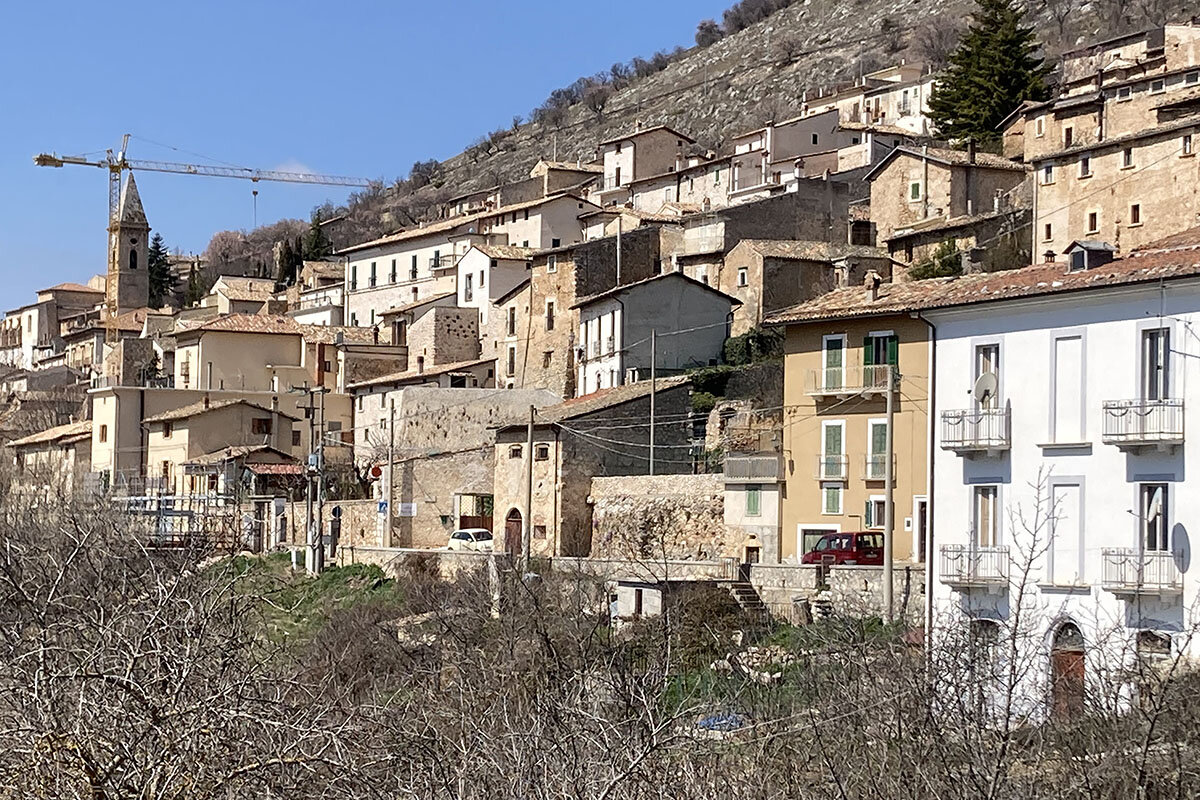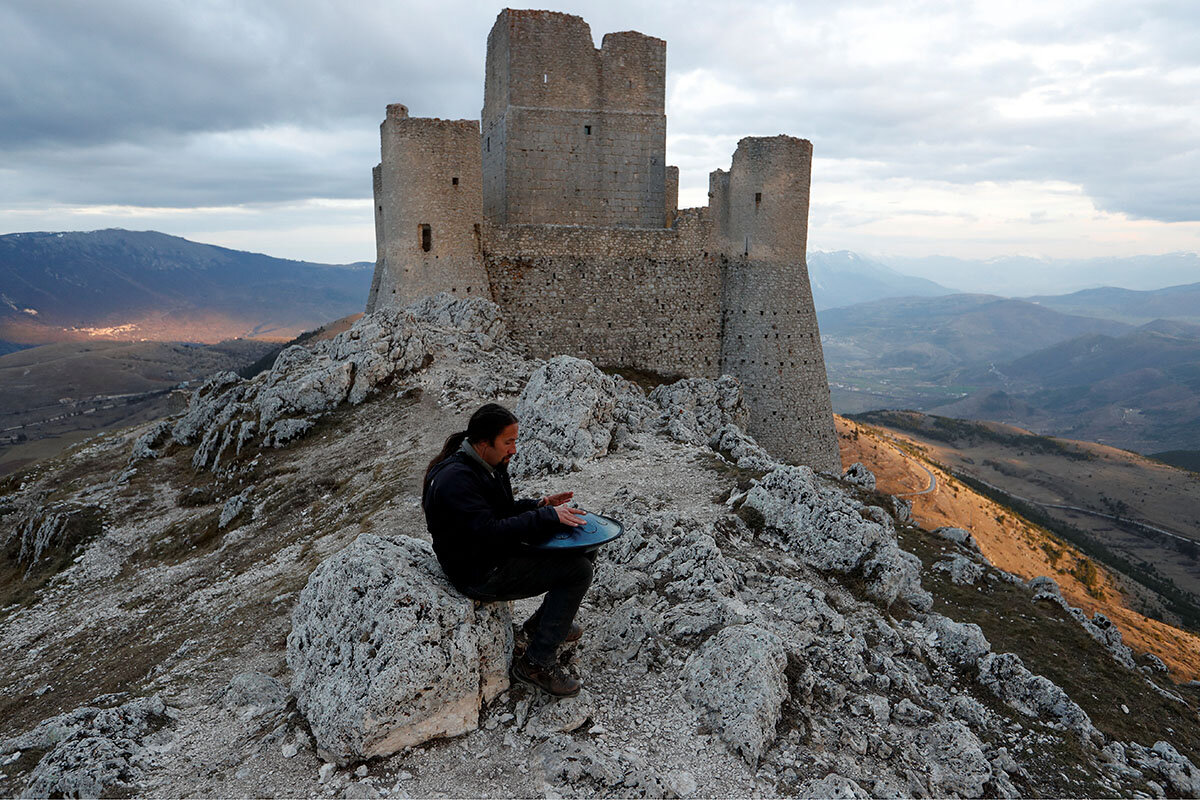Can €20 million save a dying village? Italy is about to find out.
Loading...
| Calascio, Italy
Before World War I, Calascio, a stone and timber village high in Italy’s Apennine Mountains, had a population of 2,500. That has now dwindled to less than 140.
But Calascio is one of 21 villages across Italy that are to receive €20 million ($21.7 million) each from the government in Rome. The funds are part of an unprecedented €200 billion in grants and low-interest loans that the European Union is giving to Italy to help it recover from the post-pandemic economic slump.
Why We Wrote This
When countries try to save dying villages, is it better to spread resources widely among all the needy communities, or to invest heavily in a select few? Italy is trying the latter.
About a quarter of the €20 million will be devoted to the Rocca Calascio castle, which sits atop a rocky outcrop above the village. There will be a school to teach the art of raising sheep – Calascio once grew rich on wool. Abandoned buildings will be turned into a space for new startups, with high hopes of attracting digital nomads who have the freedom to live where they want.
These projects should create around 100 jobs directly and indirectly, says the mayor.
But some have criticized the program, noting that it leaves many other villages wanting for aid. And Italy has an unhappy record of wasting public funds through red tape or corruption.
On a blustery April morning, the winding cobbled streets are largely deserted in this stone and timber village high in Italy’s Apennine Mountains.
A century ago, more than 100 children attended the local school. Now, the school is closed and just three children live in the village, one of them just a few months old – the first baby born in a decade. There were once four grocery shops; now there are none.
But all that may be about to change dramatically.
Why We Wrote This
When countries try to save dying villages, is it better to spread resources widely among all the needy communities, or to invest heavily in a select few? Italy is trying the latter.
Calascio is one of 21 villages across Italy that are to receive €20 million ($21.7 million) each from the government in Rome. The money is intended to breathe new life into Italy’s abandoned and depopulated villages by restoring abandoned buildings, attracting new residents, and reversing decades of neglect.
The funds are part of an unprecedented €200 billion in grants and low interest loans that the European Union is giving to Italy to help it recover from the post-pandemic economic slump.
A chance to restore the village
Each of Italy’s 21 regions and autonomous provinces were asked to nominate just one village to receive €20 million. Calascio was the winner for Abruzzo, a region in the middle of Italy which is known for snow-capped mountains, earthquakes, and imposing castles.
Before World War I, Calascio had a population of 2,500. That has now dwindled to less than 140, and during the harsh winters there can be as few as 90 residents. Poverty and a lack of jobs meant that families emigrated to the United States and Canada at the end of the 19th century, and later to Belgium and northern France to work in coal mines.
“Life was very hard here. The village didn’t get running water until 1911. It was poor, like so many parts of Italy. When people left, they just closed the front door and that was it. Their houses were abandoned,” says Paolo Baldi, the village mayor.
An array of projects now promise to breathe new life into the village.
The mayor wants to establish an albergo diffuso, or “spread-out hotel.” It is an Italian concept in which empty historic houses in a village are turned into accommodation, grouped around a central reception building, a restaurant, and a bar. There are also plans to establish a museum and a gallery space for local art.
About a quarter of the €20 million will be devoted to the Rocca Calascio castle, which sits atop a rocky outcrop above the village. It was named by National Geographic as one of the 15 most beautiful castles in the world and has appeared in several films.
An archaeological dig will be commissioned to explore the site and to try to establish exactly when the nearly millennium-old castle dates from. Footpaths will be laid out over areas which are rocky, uneven, and currently hard to access.
There will be a school for shepherds to teach young people the art of raising sheep – Calascio once grew rich on wool, its past wealth evident in the ornate residences that line the streets.
Abandoned buildings will be turned into a space for new start-ups, with high hopes of attracting digital nomads who have the freedom to live where they want.
These projects should, if all goes to plan, create around 100 jobs directly and indirectly, says Mayor Baldi.
Spillover effects?
But while Calascio basks in the glow of the promised funds, other villages are unhappy that they are to receive nothing.
Marco Marsilio, the governor of Abruzzo region, said it seemed unfair that the central government in Rome would devote so much cash to one community and ignore 16 other villages that had submitted applications for the money.
“The ministry’s decision to concentrate €20 million to just one winner leaves 16 other places empty-handed,” he said.
The people of Calascio argue that there will be knock-on effects for the whole area.
“They have not understood that what is good for Calascio will be good for them as well,” says Franco Cagnoli, the custodian of the castle. “If a thousand visitors arrive in one day and find nowhere to eat in Calascio then they will go looking for restaurants in other villages.”
Village bar owner Franca Fulgenzi says the impending funds will create “infinite” possibilities.
“We’re going to have to educate the locals a bit, teach them how to welcome visitors,” she says. “We’re a mountain village with a slightly closed mentality, not like a village on the coast, looking out to sea. There are some locals who just find the presence of tourists annoying.”
In a local enoteca (wine shop), where wooden tables and chairs are clustered beneath an arched stone ceiling, Paolo Quaglia serves up plates of cheese and salami. “I hope it will be a success. This is an amazing area, it’s very underrated,” he says.
The risk of corruption
The aim of investing in a select group of picturesque but struggling villages “is to create sustainable growth and to spread it right across the country,” said Dario Franceschini, Italy’s culture and tourism minister. “The potential of the internet and broadband will make these villages places of work. It’s a big challenge but this is just the beginning.”
Not everyone is convinced that throwing such large amounts of money at such small communities is necessarily a good idea. Italy has an unhappy record of wasting public funds, either through a lack of vision, too much red tape, or outright corruption.
In one of the most notorious examples, it took billions of euros and more than 50 years to complete a 275-mile stretch of highway in the south of the country, with the project dogged by interference from Calabria’s feared ‘Ndrangheta mafia.
But Mayor Baldi is confident that the windfall from the EU offers a chance to pump new blood into the village, hopefully by attracting new families to live in Calascio.
“Whether they are Italian or foreigners, it doesn’t matter. The important thing is that they live here all year round, that they don’t just visit in July and August. I think that if you offer opportunities, then people will stay.”










